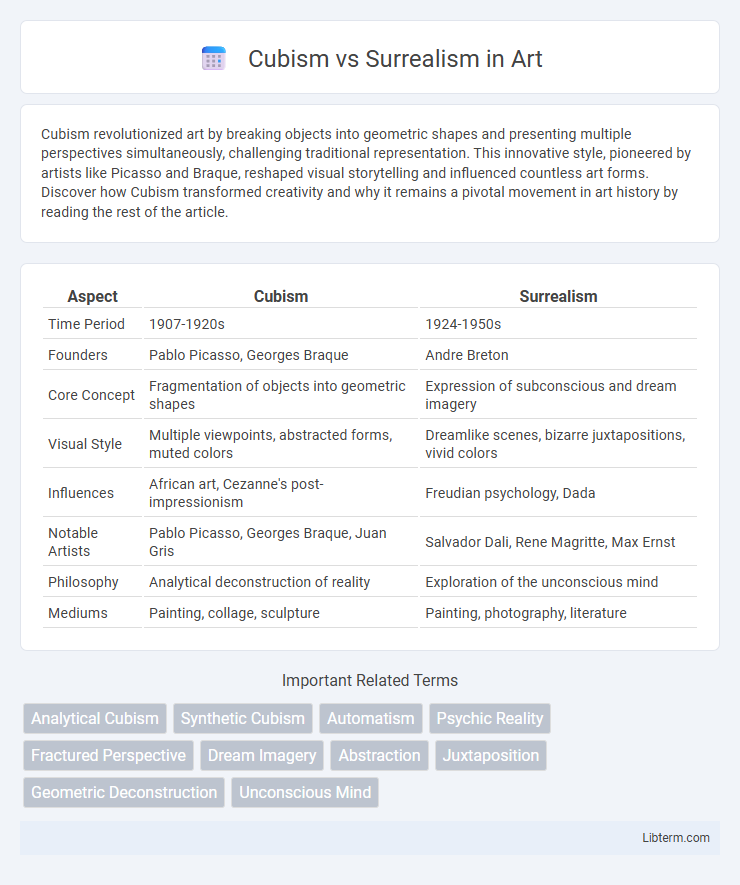Cubism revolutionized art by breaking objects into geometric shapes and presenting multiple perspectives simultaneously, challenging traditional representation. This innovative style, pioneered by artists like Picasso and Braque, reshaped visual storytelling and influenced countless art forms. Discover how Cubism transformed creativity and why it remains a pivotal movement in art history by reading the rest of the article.
Table of Comparison
| Aspect | Cubism | Surrealism |
|---|---|---|
| Time Period | 1907-1920s | 1924-1950s |
| Founders | Pablo Picasso, Georges Braque | Andre Breton |
| Core Concept | Fragmentation of objects into geometric shapes | Expression of subconscious and dream imagery |
| Visual Style | Multiple viewpoints, abstracted forms, muted colors | Dreamlike scenes, bizarre juxtapositions, vivid colors |
| Influences | African art, Cezanne's post-impressionism | Freudian psychology, Dada |
| Notable Artists | Pablo Picasso, Georges Braque, Juan Gris | Salvador Dali, Rene Magritte, Max Ernst |
| Philosophy | Analytical deconstruction of reality | Exploration of the unconscious mind |
| Mediums | Painting, collage, sculpture | Painting, photography, literature |
Introduction to Cubism and Surrealism
Cubism, developed by Pablo Picasso and Georges Braque in the early 20th century, revolutionized art by breaking objects into geometric shapes and presenting multiple perspectives simultaneously, emphasizing abstraction and fragmented forms. Surrealism, emerging in the 1920s led by Andre Breton, aimed to unlock the unconscious mind through dreamlike, bizarre imagery, blending reality with fantasy to explore deeper psychological truths. Both movements challenged traditional representation but Cubism prioritized structure and form, while Surrealism centered on imagination and the irrational.
Historical Origins and Development
Cubism emerged in the early 20th century, pioneered by Pablo Picasso and Georges Braque, revolutionizing visual art by deconstructing objects into geometric shapes and multiple perspectives. Surrealism developed in the 1920s, influenced by Dadaism and the psychoanalytic theories of Sigmund Freud, emphasizing dream imagery, unconscious desires, and irrational juxtapositions. While Cubism focused on abstract form and structure, Surrealism sought to unlock creativity through symbolic, fantastical content rooted in the subconscious mind.
Key Philosophies and Artistic Goals
Cubism emphasizes the fragmentation of objects into geometric shapes to depict multiple perspectives simultaneously, challenging traditional representations of reality. Surrealism seeks to unlock the unconscious mind by portraying dreamlike scenes and illogical juxtapositions, aiming to uncover deeper truths beyond rational thought. Both movements revolutionized art by redefining reality: Cubism through analytical abstraction and Surrealism through imaginative expression.
Influential Artists of Cubism and Surrealism
Pablo Picasso and Georges Braque are the foundational figures of Cubism, pioneering fragmented perspectives and abstract forms that revolutionized early 20th-century art. Surrealism's influence is epitomized by Salvador Dali and Rene Magritte, whose work explores dreamlike imagery and unconscious symbolism. Both movements reshaped artistic expression by challenging traditional representation, with Cubism emphasizing geometric abstraction and Surrealism delving into psychological and fantastical realms.
Visual Styles and Techniques
Cubism emphasizes fragmented, geometric shapes and multiple perspectives within a single plane, often employing monochromatic palettes and abstracted forms to challenge traditional representation. Surrealism focuses on dreamlike, fantastical imagery with fluid, organic shapes, using techniques like automatism and juxtaposition to explore the unconscious mind. Both movements revolutionize visual storytelling by manipulating form and reality but diverge in their approach: Cubism deconstructs reality analytically, while Surrealism delves into imaginative, subconscious expression.
Major Works and Iconic Pieces
Cubism's major works include Pablo Picasso's "Les Demoiselles d'Avignon" and Georges Braque's "Violin and Candlestick," which emphasize fragmented forms and multiple perspectives. Surrealism's iconic pieces feature Salvador Dali's "The Persistence of Memory" and Rene Magritte's "The Son of Man," renowned for dreamlike imagery and unexpected juxtapositions. Both movements revolutionized visual art by challenging traditional representation through distinct yet influential masterpieces.
Use of Color, Form, and Space
Cubism emphasizes fragmented forms, geometric shapes, and a muted color palette to deconstruct objects from multiple perspectives simultaneously. Surrealism employs vivid, dreamlike colors with fluid, often distorted forms that challenge reality and explore the subconscious mind. In terms of space, Cubism flattens the pictorial plane and merges background with foreground, while Surrealism creates illogical, expansive spaces to evoke a sense of mystery and irrationality.
Impact on Modern Art Movements
Cubism revolutionized modern art by deconstructing objects into geometric forms, influencing movements like Futurism and Abstract Expressionism through its emphasis on multiple perspectives. Surrealism expanded artistic boundaries by exploring the unconscious mind and dream imagery, shaping subsequent styles such as Abstract Surrealism and Pop Art. Both movements profoundly impacted visual language, encouraging experimentation and challenging traditional representation in 20th-century art.
Critical Reception and Legacy
Cubism, pioneered by Pablo Picasso and Georges Braque, revolutionized early 20th-century art by challenging traditional perspectives and emphasizing geometric abstraction, receiving mixed critical reception initially but ultimately being hailed as a foundational movement in modern art. Surrealism, led by Andre Breton and Salvador Dali, emerged in the 1920s embracing the unconscious mind and dream imagery, which garnered both acclaim for its imaginative boldness and criticism for its perceived irrationality. Both movements significantly influenced later artistic developments, with Cubism shaping abstract and conceptual art and Surrealism impacting visual arts, literature, and film through its exploration of the subconscious.
Comparing Cubism and Surrealism Today
Cubism and Surrealism continue to influence contemporary art by challenging traditional perspectives and exploring new visual languages. Cubism's fragmentation and multiple viewpoints contrast with Surrealism's focus on the subconscious and dreamlike imagery, both shaping modern artistic expression. Today, artists blend these movements to create innovative works that emphasize abstraction, psychological depth, and experimental forms.
Cubism Infographic

 libterm.com
libterm.com